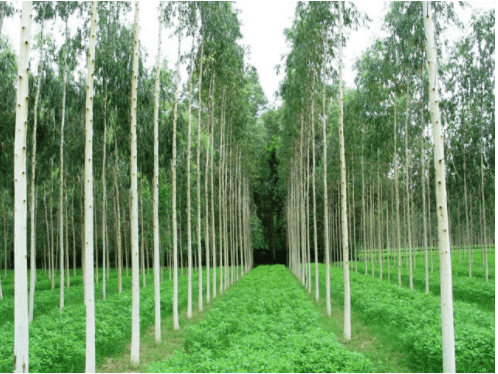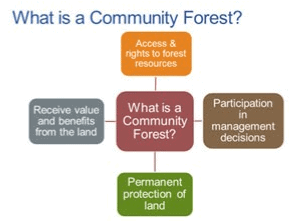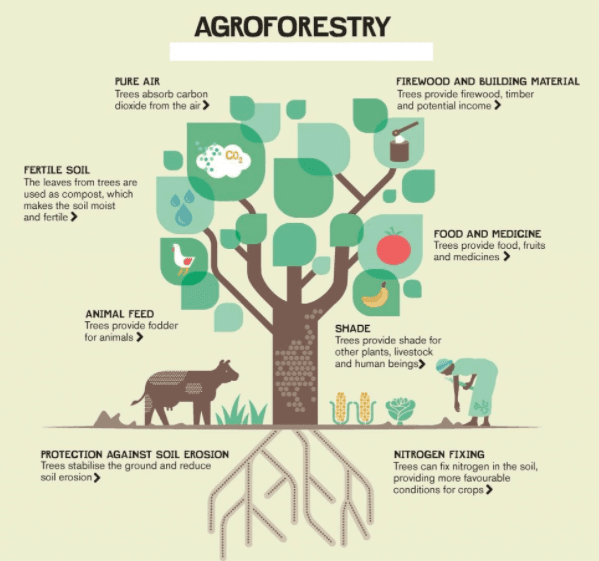Social Forestry & Agroforestry | Geography Optional for UPSC PDF Download
Social Forestry
- Social forestry refers to the practice of managing and cultivating forests to provide environmental benefits and support rural development. This concept was first introduced by the National Commission on Agriculture, Government of India, in 1976. The aim of the social forestry project was to alleviate the pressure on existing forests by utilizing unused and fallow lands for afforestation.
- The project focused on the reforestation of government-owned lands that were located near human settlements and had been degraded over time due to human activities. Trees were planted in and around agricultural fields, as well as along railway lines, roadsides, riverbanks, and canal banks. Additionally, trees were planted on village common lands, government wastelands, and Panchayat lands.
- To ensure the proper care and maintenance of the newly planted saplings, the government provided incentives to the local population. Initially, the government promoted the free distribution of usufruct species, which are plants that provide useful products to the community. The social forestry program was designed as a mass mobilization initiative, aiming to actively involve the general public in its implementation.
Benefits of Social forestry Programme
- The Social Forestry Programme aims to provide alternative non-farm income options for impoverished farmers and landless laborers while also promoting better land use through the conversion of wastelands into forestry plantations. This initiative is part of an afforestation scheme that seeks to increase India's forested area to meet the target of 33% coverage.
- Furthermore, the program supports wasteland development by encouraging the use of forestry land on slopes and upstream areas. By introducing the Social Forestry Programme, the government has formally acknowledged local communities' rights to forest resources and has begun promoting rural participation in managing natural resources.
- Through this scheme, the government has engaged local communities in afforestation efforts and the rehabilitation of degraded forest and common lands. This approach not only encourages sustainable land use and resource management but also fosters a sense of ownership and responsibility among rural populations.
Shortcomings of Social forestry Programme
- The Social Forestry Programme in India aimed to be a revolutionary concept, but it did not achieve significant success due to various shortcomings, predominantly related to its implementation. The program offered incentives to farmers and villagers to encourage them to participate in social forestry initiatives. However, this led to many farmers converting their agricultural land to forestry, which negatively impacted agricultural prospects and food security.
- Additionally, the program recommended the use of usufruct species, but due to a lack of ecological understanding and specific directives, most of the plantations opted to grow eucalyptus. This species is not ecologically suitable for the Indian environment, further hampering the effectiveness of the Social Forestry Programme. Overall, the program's limitations can be attributed to inadequate implementation strategies and a lack of ecological understanding among its participants.
Types of Social Forestry
The various types of social forestry systems are shown in the chart below:

Farm forestry
- Currently, nearly all countries that have implemented social forestry programs are promoting both commercial and non-commercial farm forestry in various forms. Individual farmers are encouraged to cultivate trees on their own land to meet their family's domestic needs. In many regions, this practice of growing trees on farmland is already a tradition.
- Non-commercial farm forestry is the primary focus of most social forestry projects in numerous countries today. Farmers may not always be interested in growing trees for fuelwood or economic gain. Instead, they may grow trees for other purposes, such as providing shade for their crops, acting as wind barriers, aiding in soil conservation, or utilizing wasteland.

Urban Forestry
- Urban forestry involves the cultivation and management of trees situated on private or public lands in and around urban areas, with the aim of enhancing the urban environment.
- This practice encompasses the care of individual trees as well as groups of trees and is not limited to those that have been intentionally planted.
- Many urban trees may have grown naturally, but due to the competition for land in urban settings, they are unlikely to survive for an extended period without active cultivation and management.
- Additionally, urban forestry entails the administration of forests located on the outskirts of urban zones.

Rural Forestry
Rural forestry can be divided into:
- Community forestry
- Agroforestry
1. Community forestry
- Community forestry involves the cultivation of trees on communal land rather than on private property, as seen in farm forestry. These programs are designed to benefit the entire community rather than individuals. The government is responsible for providing essential resources like seedlings and fertilizers, while the community must ensure the protection of the trees.
- Some communities manage these plantations in a sustainable and sensible manner, ensuring long-term benefits for the village. However, others may exploit the resources for short-term personal gains, especially since communal land is easily accessible to all.
- Over the past two decades, there has been a significant increase in the planting of fast-growing trees like eucalyptus in India. This initiative is part of the social forestry movement, aimed at reforesting the region and providing a sufficient supply of timber for rural communities.

2. Agro forestry
- Agroforestry is a sustainable land-use system that combines trees and shrubs with agricultural practices to enhance productivity, profitability, biodiversity, and ecosystem stability. This natural resource management approach involves the integration of woody plants on farms and rural landscapes, promoting diverse and sustainable production while also supporting social institutions.
- The main features of agroforestry include the production of multiple outputs while protecting natural resources, a focus on using various indigenous trees and shrubs, suitability for low-input conditions and fragile environments, strong connections with socio-cultural values, and a more complex structure and function than monoculture farming.
- Agroforestry systems encompass both traditional and modern land-use practices where trees are managed alongside crops and/or livestock. These systems can be implemented in both irrigated and rain-fed conditions and contribute to food, fuel, fodder, timber, fertilizer, and fiber production. Moreover, agroforestry plays a significant role in ensuring food, nutritional, and ecological security, supporting livelihoods, reducing poverty, and fostering productive and resilient farming environments.
- In addition to these benefits, agroforestry can enhance ecosystem services such as carbon sequestration, deforestation prevention, biodiversity conservation, and soil and water preservation. When implemented strategically with the right mix of species and on a large scale, agroforestry can also help agricultural lands better withstand extreme weather events like floods and droughts, as well as adapt to climate change.

Benefits of Agroforestry System
1. Environmental benefits:
- Reduced strain on natural forests: Agroforestry helps in decreasing the pressure on natural forests by providing alternative sources of timber, fuelwood, and other forest products.
- Enhanced nutrient recycling: Deep-rooted trees in agroforestry systems promote efficient nutrient recycling within the soil, contributing to better soil fertility and productivity.
- Protection of ecosystems: Agroforestry practices help in maintaining and preserving ecological systems by integrating trees with agriculture, thereby promoting biodiversity.
- Soil conservation: Tree roots and stems in agroforestry systems help to reduce surface runoff, nutrient leaching, and soil erosion, leading to improved soil quality and sustainability.
- Improved microclimates: Agroforestry systems contribute to the creation of better microclimates by lowering soil surface temperatures and reducing evaporation rates through mulching and shading effects.
- Increased soil nutrients: The addition and decomposition of litterfall in agroforestry systems result in an increase in soil nutrients, further enhancing the soil quality and productivity.
- Enhanced soil structure: The continuous addition of organic matter from decomposed litter in agroforestry systems improves the overall soil structure.
- Contribution to national forest policy goals: Agroforestry is considered a crucial strategy for achieving the target of increasing forest or tree cover to 33% from the current level of less than 25%, as outlined in the National Forest Policy (1988).
- Climate change mitigation: Agroforestry has the potential to mitigate climate change effects through microclimate moderation and natural resource conservation in the short term and carbon sequestration in the long term. Agroforestry species are known to sequester as much carbon in below-ground biomass as primary forests, and significantly more than crop and grass systems.
2. Economic benefits
- Agroforestry leads to increased production of food, fuelwood, fodder, fertilizer, and timber, contributing to economic growth. By diversifying crops and avoiding monoculture systems, agroforestry reduces the likelihood of complete crop failure, which can devastate farmers' livelihoods.
- Farmers benefit from improved and sustained productivity, resulting in higher income levels. Agroforestry also presents significant employment opportunities for both rural and urban populations through production, industrial applications, and value-added ventures. It is estimated that around 65% of a country's timber needs can be met through trees grown on farms using agroforestry practices.
- In summary, agroforestry offers numerous economic benefits, including increased output in various sectors, improved income for farmers, reduced risk of crop failure, and ample employment opportunities for the population.
3. Social benefits
- Enhancement of living conditions in rural areas due to continuous employment opportunities and increased income levels.
- Betterment of overall health and nutrition as a result of higher quality and diverse food production.
- Strengthening and advancement of communities by removing the necessity to relocate farming operations.

Conclusion
In conclusion, social forestry is a crucial approach towards sustainable land use and rural development. By involving local communities in afforestation efforts and promoting practices like farm forestry, urban forestry, community forestry, and agroforestry, the program aims to provide environmental, economic, and social benefits. Although the Social Forestry Programme in India has faced certain challenges and shortcomings, the potential advantages of such initiatives cannot be ignored. Agroforestry, in particular, plays an essential role in enhancing productivity, preserving ecosystems, and promoting socio-economic well-being. Therefore, continued efforts to improve the implementation and management of social forestry programs are vital for achieving sustainable development goals and ensuring the long-term welfare of communities and the environment.Frequently Asked Questions (FAQs) of Social Forestry & Agroforestry
What is the main goal of the Social Forestry Programme in India?
The main goal of the Social Forestry Programme is to alleviate pressure on existing forests by utilizing unused and fallow lands for afforestation, thereby providing environmental benefits and supporting rural development.
How does social forestry contribute to sustainable land use and resource management?
Social forestry encourages the planting of trees on degraded lands, promoting better land use and helping to rehabilitate degraded forest and common lands. By involving local communities in afforestation efforts, social forestry fosters a sense of ownership and responsibility among rural populations, leading to more sustainable land use and resource management.
What are some of the shortcomings of the Social Forestry Programme in India?
The Social Forestry Programme has faced challenges due to inadequate implementation strategies, lack of ecological understanding among participants, and unintended consequences such as the conversion of agricultural land to forestry, impacting food security. Additionally, the use of unsuitable tree species like eucalyptus has hampered the program's effectiveness.
What are the main types of social forestry?
The main types of social forestry include farm forestry, urban forestry, and rural forestry, which can be further divided into community forestry and agroforestry.
How does agroforestry contribute to environmental, economic, and social benefits?
Agroforestry contributes to environmental benefits by reducing pressure on natural forests, enhancing nutrient recycling, protecting ecosystems, conserving soil, improving microclimates, and mitigating climate change. Economically, agroforestry leads to increased production, higher income levels for farmers, and employment opportunities in various sectors. Social benefits include improved living conditions, better health and nutrition, and strengthened communities due to continuous employment opportunities and increased income levels.
|
303 videos|635 docs|252 tests
|
FAQs on Social Forestry & Agroforestry - Geography Optional for UPSC
| 1. What is social forestry? |  |
| 2. What is agroforestry? |  |
| 3. What are the objectives of social forestry? |  |
| 4. How does social forestry contribute to sustainable development? |  |
| 5. What are the challenges faced in implementing social forestry and agroforestry? |  |
















